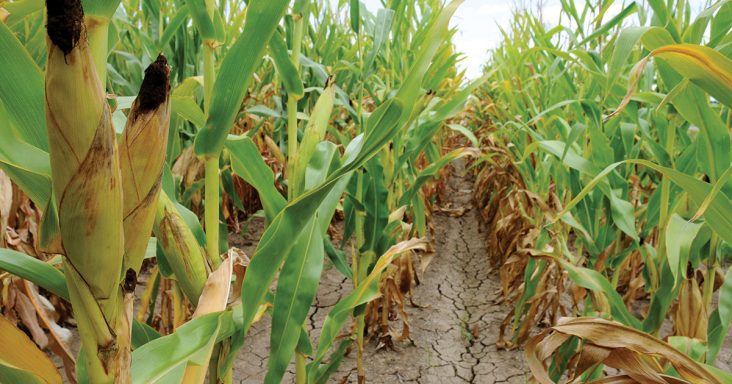June crop numbers provide ‘reality check’ for March planting report
by August 8, 2024 8:09 pm 256 views

An Arkansas corn field.
Cotton acres in Arkansas have surged to a decade high, while corn acres have plummeted, according to the June acreage report from the U.S. Department of Agriculture’s National Agricultural Statistics Service (NASS).
Principal crops planted acreage is down 0.8% to 7.15 million acres in Arkansas, while the total planted in the U.S. is 315 billion acres, down 1.4% from the previous year, NASS said.
Soybean acres in the Natural State are slightly up as compared to a year ago, but are slightly down from earlier spring projections. Rice acres were down slightly as well, while peanut acres remained unchanged from 2023.
“June acreage is more or less a reality check for the March ‘Planting Intentions’ report,” said Scott Stiles, extension agricultural economics program associate for the University of Arkansas System Division of Agriculture.
Corn acres dropped 27.1% to 620,000 acres, unchanged from the March planting intentions.
“Corn prices have been on a downward slide for much of the past year,” Stiles said. “Futures prices for new crop corn were about 20% below the previous year when NASS surveyed growers in early March.”
Jason Kelley, extension wheat and feed grains agronomist for the Division of Agriculture, said he wasn’t surprised by the acreage report.
“Lower grain prices, combined with less-than-ideal planting conditions for some, led to the drop in Arkansas acres. The spring was too wet, especially in the southern half of the state. Northeast Arkansas overall had better planting conditions than the rest of the state, with dry weather in late March and early April,” Kelley said.
Cotton acres were up 31.4% to 670,000 acres in Arkansas, while total U.S. acres were also up 14.1%. It’s the most cotton acres in Arkansas since 680,000 were harvested in 2011.
“The huge surprise in this report was NASS’ cotton acreage number,” Stiles said. “In March, growers indicated they would increase acres by a modest 30,000 acres to 540,000.
“Cotton prices started a nosedive in early April, losing about 13 cents by mid-June. Prices fell from the low 80-cent level to 70 cents. But, cotton yields in the state continue to climb and growers exited 2023 with record yields. And the crop insurance price of 82 cents this year may have played a role in adding acres. There was some shifting from corn to cotton going on as well.”
NASS pinned peanuts at 35,000 acres, the same as in 2023.
“The peanut crop is in pretty good shape. We had some growers that had to go back and replant after extensive rainfall. Some growers are reporting their crop pegging,” Zachary Treadway, extension cotton and peanut agronomist said.
Overall, total rice acres were down 15,000 acres from last year in NASS’ findings to 1.42 million acres, compared to just under 1.44 million acres in 2023. Stiles said he was a little surprised by the 40,000-acre decline in long-grain rice acres from March.
“The June survey results are a little puzzling considering the planting progress this year and the rice market rally that kicked off in early April,” he said. “Generally, in years when planting progresses at a faster than average pace, we tend to see a higher acreage number in June. USDA did increase medium grain acres by 10,000 above their March number.”
Jarrod Hardke, rice extension agronomist for the Division of Agriculture, said he too was surprised by the dip, but said it was within his range of expectations between 1.4 million and 1.5 million acres. A shortage of long-grain seed shortage played into the shuffling of acres over to medium grain, he said.
“One of the hardest things to gauge every year is the expected long and medium grain acreage, and then with a seed shortage out of the gate, that changed the mix. And it got very, very weird,” he said.
There were also some missed planting opportunities during good weather windows as growers, unable to get the seed they wanted, scrambled to find varieties to plant. NASS lowered Arkansas soybean acres by 50,000 from the March intentions to 3.05 million, however that was still up 2.3% from 2023. The U.S. total was up 3% to 86.1 billion acres.
“This is still an increase of 2% or 70,000 acres over last year,” Stiles said. “Considering the sharp drop in corn acres, some resulting increase in soybeans is not a surprise. Similar to corn, soybean prices have trended lower over the past year as well. As planting kicked off in the state, soybean prices were about 13% to 14% lower compared to the prior year. November ‘24 soybeans settled at $11.04 today. A year ago the November contract traded at $12.66, right ahead of a summer rally that carried prices above $14 last July. A very bearish feel to the soybean and corn markets this year.”
“The estimates were in line with what I was expecting. We had another really good start with early plantings similar to the 2023 season,” said Jeremy Ross, extension soybean agronomist. “This year’s soybean crop ranges from early planted fields beginning to fill pods to fields that were planted within the last two days. With the drop in soybean prices compared to last year, I’m getting a few more calls with farmers and consultants asking about different inputs preserving or increasing soybean yields.”
Winter wheat acres declined 39.1% from 2024 to 140,000 acres. That followed the larger national trend with U.S. winter wheat down 7.9% to 33.8 billion acres. Kelley said the decline was likely due to “lower prices for grain and lower relative profitability compared to other crops.”
